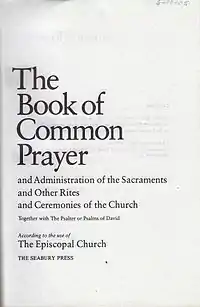Book of Common Prayer (1979)
The 1979 edition of the Book of Common Prayer is the official liturgical book of the US-based Episcopal Church. It is similar to versions of the Book of Common Prayer used by other churches within the Anglican Communion.

Overview
In 1979 a revision to the Book of Common Prayer that was more substantial than the ones before it was made under the influence of the Liturgical Movement. Its most distinctive feature may be the presentation of two rites for the Holy Eucharist and for Morning and Evening Prayer. The Rite I services keep most of the language of the 1928 edition and older books, while Rite II uses contemporary language and offers a mixture of newly composed texts, some adapted from the older forms, and some borrowed from other sources, notably Byzantine rites. The Book also offers changed rubrics and the shapes of the services, which were generally made for both the traditional and contemporary language versions.
Article X of the Canons of the Episcopal Church provides that "[t]he Book of Common Prayer, as now established or hereafter amended by the authority of this Church, shall be in use in all the Dioceses of this Church," which, of course, is a reference to the 1979 Book of Common Prayer.[lower-alpha 1] Many traditionalists, both Anglo-Catholics and Evangelicals, felt alienated by the theological and ritual changes made in the 1979 BCP, and resisted or looked elsewhere for models of liturgy. In 1991 the Anglo-Catholic Church of the Good Shepherd (Rosemont, Pennsylvania) published a book entitled, the Anglican Service Book which is "a traditional language adaptation of the 1979 Book of Common Prayer together with the Psalter or Psalms of David and Additional Devotions." In 2000, the church's General Convention issued an apology to those "offended or alienated during the time of liturgical transition to the 1979 Book of Common Prayer."
At the General Convention of 2018, a resolution was passed to create a "Task Force on Liturgical and Prayer Book Revision." The charge of this group was to "engage worshiping communities in experimentation and the creation of alternative texts" to incorporate more inclusive language and provide a greater focus on the care of God's creation. It also suggested that the Task Force take into consideration new technological means of disseminating the prayer book and to conduct its business in the major languages of The Episcopal Church: English, Spanish, French and Haitian Creole.[1][2]
References
- Some parishes continued to use the 1928 book either regularly or occasionally, for pastoral sensitivity, for doctrinal reasons and for the beauty of its language. See"Parishes using the Historic Book of Common Prayer". Archived from the original on 2009-06-22. Retrieved 2010-04-28. The controversies surrounding the Book of Common Prayer contrasts with the Episcopal Church’s description of it as "the primary symbol of our unity." Diverse members "come together" through "our common prayer." See "The Book of Common Prayer". episcopalchurch.org. 2015. Retrieved 2016-06-03.
Sources
- The Book of Common Prayer, ISBN 9780898690804
External links
| Part of a series on |
| Anglicanism |
|---|
 |
|
|